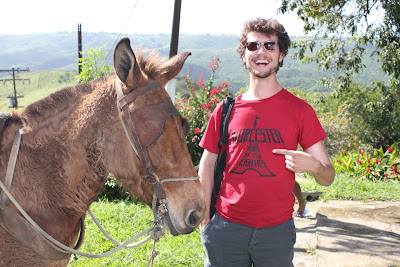* * *
I had read about it previously, but didn't really believe it until I heard it again in one of our lectures.
Back in the States I read that Pelourinho and much of Cidade Alta had been rough area just a decade before (drugs, prostitution, crime, etc). Upon arriving though I was shocked to see a very clean-cut (almost cookie-cutter) neighborhood with the same old style architecture and colors used by early Portuguese settlers. How could this be an area like the books had described? Something didn't add up.
I was disheartened when my suspicions were confirmed. The area hadn't been improved, it had been gentrified. Instead of helping the people in need, Salvador had swept them away to the favelas to create something that they could show off to tourists. In my opinion this is always a temporary and very unstable solution, but Salvador is a city built on tourism and they needed a tourism center, so they took action. Worse still however, was the reconstruction of the area was only skin deep. Many of the buildings, were just made to look nice from the street, while their insides sat vacant and rotting. After I heard that I couldn't help walking through Pelourinho and feel like I was in Disney World with cardboard cut-out buildings surrounding me and a subtle "It's a small world" ringing in my ears. I felt a little cheated. I felt hoodwinked. I loved Pelourinho, but was it really Brasil?
A little of this bitterness started to carry over to my stay in Brasil. How much of my experience was simply a tourist facade? Admittedly, it started to bum me out.
But then I took a deeper look, a look beyond the plastic-y surface of Pelo. I was staying with a family that would bend over backwards to help me see what they see. They had taken me to their family house on Itapirica, to their favorite samba club, to play in a soccer tournament with their friends. They didn't stop at the surface, they opened their hearts and their home to a couple of gringos that for all they know could have been there because their parents in the U.S. wanted them out of the house.
My family helped me see the real beauty of Brasil, not just the picture-happy tourist trap. They helped me appreciate that short 15-minute walk down to Porto da Barra, helped me appreciate that R$5 acaraje that became R$3 after bartering away the "gringo turista tax" and the R$2 tallboy of ice-cold (and I mean ice-cold) Skol. They helped me appreciate sitting in the sand, watching futevoli (soccer volleyball) while the sun lit the sky on fire over Itapirica across the bay. No matter how many street vendor's were there hocking useless trinkets and how many plastic facades dot Salvadorian storefronts, that's a moment you can't fake. That's something I'll never forget. That's Brasil. That's real.
Obrigado Familia.


No comments:
Post a Comment